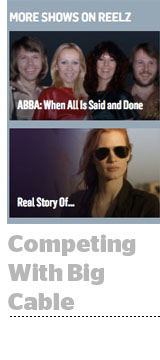
Reelz, an independent cable and satellite TV network, combines technology and direct sales to compete with larger media conglomerates.
Although Reelz has added more than 75 new advertisers in the last two years, competition is steep with a sea of brands such as E!, Entertainment Tonight and TMZ dominating the celebrity and entertainment category.
But even these mainstream entertainment brands aren’t immune to the viewer migration to streaming environments.
“C3 ratings are down anywhere from 7-10% across the television marketplace, which is why some independent networks are doing well,” said Bill Rosolie, SVP of national advertising sales for Reelz. “Buyers are looking for places to put impressions where there used to be opportunities, but aren’t anymore because [of cord cutting].”
Rather than run-of-the-mill red carpet coverage, Reelz differentiates itself by reporting the real lives and stories in entertainment, including its airing of the award-winning miniseries “The Kennedys.”
Reelz claims to reach 70 million TV households via traditional cable and satellite providers, such as Dish and DirecTV. It also reaches viewers through a slew of live and on-demand services, including Sling TV and Amazon Channels.
Because Reelz is backed by the independent, family-owned Hubbard Broadcasting, it’s naturally more resource-constrained than bigger cable networks and doesn’t have the luxury of a large sales and data science team.
Reelz instead uses a hybrid of technology and traditional account management to propel its ads business.
Most of Reelz’ business is direct sold, so it often relies on historical data around a brand’s ad spend and creative to customize pitches with prospective planners and buyers.
Reelz uses MediaRadar to first track TV ad spend across brands, categories, programs and dayparts.
“The second thing we use it for is finding the right prospect at the client or agency level,” Rosolie said. “Being a smaller, independent network, there is much less bureaucracy and red tape, but you have to do a lot of legwork yourself. Having relationships is important, so we’re using MediaRadar when we do our outreach, and it’s made it a little easier in interactions with video investment groups.”
Reelz is also no stranger to programmatic. It was an early supply partner to the Magna Consortium, IPG Mediabrands’ premium and long-tail TV marketplace, as early as 2015.
Now, it sells a portion of inventory programmatically, mostly via the open exchange, to achieve more scale, and it is working to automate more of its sales workflow using WideOrbit.
Reelz is onboarding WideOrbit’s audience optimizer for ad trafficking and scheduling, and it is also evaluating its analytics offering.
Although more data and automation will increasingly be used in future TV media-buying transactions, Rosolie doesn’t predict traditional sales will ever disappear.
“When people predict the upfronts will go away, do they know what the staffing requirements would be to take $20 billion in the marketplace and execute it on a scatter basis?” he said. “Automation does make things easier, but our numbers are up substantially in the upfront, and it’s going to continue to be a big part of our revenue piece.”
This post was syndicated from Ad Exchanger.

More Stories
Scroll Media boosts in-game advertising with new feature
Kiwi filmmaker spotlights media struggles at top global awards
T-Mobile Has Appointed Kristin Harrer As Senior Vice President and Chief Brand Officer